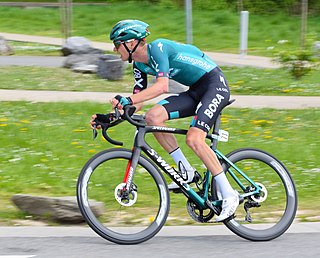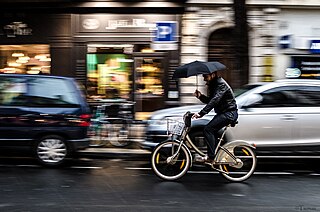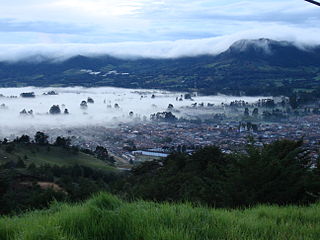Related Research Articles

Cycling, also known as bicycling or biking, is the activity of riding a bicycle or other type of cycle. It encompasses the use of human-powered vehicles such as balance bikes, unicycles, tricycles, and quadricycles. Cycling is practised around the world for purposes including transport, recreation, exercise, and competitive sport.

A triathlon is an endurance multisport race consisting of swimming, cycling, and running over various distances. Triathletes compete for fastest overall completion time, racing each segment sequentially with the time transitioning between the disciplines included. The word is of Greek origin, from τρεῖς or treis (three) and ἆθλος or athlos (competition).

BMX, an abbreviation for bicycle motocross or bike motocross, is a cycle sport performed on BMX bikes, either in competitive BMX racing or freestyle BMX, or else in general street or off-road recreation.

The car-free movement is a broad, informal, emergent network of individuals and organizations, including social activists, urban planners, transportation engineers, environmentalists and others, brought together by a shared belief that large and/or high-speed motorized vehicles are too dominant in most modern cities. The goal of the movement is to create places where motorized vehicle use is greatly reduced or eliminated, by converting road and parking space to other public uses and rebuilding compact urban environments where most destinations are within easy reach by other means, including walking, cycling, public transport, personal transporters, and mobility as a service.

Road cycling is the most widespread form of cycling in which cyclists ride on paved roadways. It includes recreational, racing, commuting, and utility cycling. As users of the road, road cyclists are generally expected to obey the same laws as motorists, however there are certain exceptions. While there are many types of bicycles that are used on the roads such as BMX, recumbents, racing, touring and Utility bicycles, dedicated road bicycles have specific characteristics that make them ideal for the sport. Road bicycles have thinner tires, lighter frames with no suspension, and a set of drop handle bars to allow riders to get in a more aerodynamic position while cycling at higher speeds. On a flat road, an intermediate cyclist can average about 18 to 20 mph, while a professional rider can average up to 25 mph (40 km/h). At higher speeds, wind resistance becomes an important factor; aerodynamic road bikes have been developed over the years to ensure that as much as possible of the rider's energy is spent propelling the bike forward.

Cyclo-cross is a form of bicycle racing. Races typically take place in the autumn and winter, and consist of many laps of a short course featuring pavement, wooded trails, grass, steep hills and obstacles requiring the rider to quickly dismount, carry the bike while navigating the obstruction and remount. Races for senior categories are generally between 40 minutes and an hour long, with the distance varying depending on the ground conditions. The sport is strongest in the traditional road cycling countries such as Belgium, France and the Netherlands.
Cycle sport is competitive physical activity using bicycles. There are several categories of bicycle racing including road bicycle racing, cyclo-cross, mountain bike racing, track cycling, BMX, and cycle speedway. Non-racing cycling sports include artistic cycling, cycle polo, freestyle BMX, mountain bike trials, hardcourt bike polo and cycleball. The Union Cycliste Internationale (UCI) is the world governing body for cycling and international competitive cycling events. The International Human Powered Vehicle Association is the governing body for human-powered vehicles that imposes far fewer restrictions on their design than does the UCI. The UltraMarathon Cycling Association is the governing body for many ultra-distance cycling races.

Vehicles that have two wheels and require balancing by the rider date back to the early 19th century. The first means of transport making use of two wheels arranged consecutively, and thus the archetype of the bicycle, was the German draisine dating back to 1817. The term bicycle was coined in France in the 1860s, and the descriptive title "penny farthing", used to describe an "ordinary bicycle", is a 19th-century term.

The Schwinn Bicycle Company is an American company that develops, manufactures and markets bicycles under the eponymous brand name. The company was originally founded by Ignaz Schwinn (1860–1948) in Chicago in 1895. It became the dominant manufacturer of American bicycles through most of the 20th century. Schwinn first declared bankruptcy in 1992, in 2001 Schwinn went bankrupt again and was purchased by Pacific Cycle, now owned by the Dutch conglomerate, Pon Holdings.

Downhill mountain biking (DH) is a style of mountain biking practiced on steep, rough terrain that often features jumps, drops, rock gardens and other obstacles. Jumps can be up to and including 12 meters, and drops can be greater than 3 meters.

The dandy horse, a derogatory term for what was first called a Laufmaschine, then a vélocipède or draisienne, and then a pedestrian curricle or hobby-horse, or swiftwalker, is a human-powered vehicle that, being the first means of transport to make use of the two-wheeler principle, is regarded as the forerunner of the bicycle. The dandy horse is a foot-propelled vehicle, powered by the rider's feet on the ground instead of the pedals of later bicycles. It was invented by Karl Drais in 1817, and then patented by him in France in February 1818 using the term vélocipède. It is also known as a Draisine, and as a draisienne (French:[drɛzjɛn] in French and English. In English, it is also sometimes still known as a velocipede, but that term now also has a broader meaning.

Bogotá is the Americas city with the most extensive and comprehensive network of bike paths with a total of 564 kilometers at year 2022. Bogotá’s bike paths network or Ciclorrutas de Bogotá in Spanish, designed and built and is also one of the most extensive in the world.

Ciclovía, also ciclovia or cyclovia, is a Spanish term that means "cycleway", either a permanent bike path or the temporary closing of certain streets to automobiles for cyclists and pedestrians, a practice sometimes called open streets.

USA Cycling or USAC, based in Colorado Springs, Colorado, is the national governing body for bicycle racing in the United States. It covers the disciplines of road, track, mountain bike, cyclo-cross, and BMX across all ages and ability levels. In 2015, USAC had a membership of 61,631 individual members.

Cycling is a common means of transportation, sport, and recreation in Paris, France. As of 2021, about 15% of trips in the city are made by bicycle, taking place on over 1,000 km (620 mi) of cycling paths. The Tour de France, the largest sporting event in cycling, finishes on the Champs-Élysées. Four major recreational cycling routes—EuroVelo 3, Avenue Verte, the Seine à Vélo, and the Veloscenic—pass by Notre-Dame Cathedral.

Cycling infrastructure is all infrastructure cyclists are allowed to use. Bikeways include bike paths, bike lanes, cycle tracks, rail trails and, where permitted, sidewalks. Roads used by motorists are also cycling infrastructure, except where cyclists are barred such as many freeways/motorways. It includes amenities such as bike racks for parking, shelters, service centers and specialized traffic signs and signals. The more cycling infrastructure, the more people get about by bicycle.

Divvy is the bicycle sharing system in the Chicago metropolitan area, currently serving the cities of Chicago and Evanston. The system is owned by the Chicago Department of Transportation and has been operated by Lyft since 2019. As of Sept 2021, Divvy operated 16,500 bicycles and over 800 stations, covering 190 square miles.

La Ceja del Tambo, known as La Ceja, is a town and municipality in the Antioquia Department of Colombia. It is part of the subregion of Eastern Antioquia. La Ceja borders the Rionegro and Carmen de Viboral municipalities to the north, La Unión to the east, and Montebello and Retiro to the west. It is located approximately 41 kilometers from Medellín, the department capital.

Cycling is a mode of transport in Spain with 20% of the people listing the bicycle as their mode of transport, though some Spanish cities as Valencia, Vitoria and Zaragoza well exceed that with 45%.

Jhonnatan Botero Villegas is a Colombian mountain bike racer. Among his most important achievements are the team gold medal obtained at the 2010 Singapore Youth Olympic Games and the fifth place in mountain biking at the 2016 Rio de Janeiro Olympic Games.
References
- ↑ Daniels, Joe Parkin (2019-10-02). "'We live for gravity biking': deadly sport is way of life in Medellín". The Guardian. ISSN 0261-3077 . Retrieved 2019-10-03.
- ↑ "Risking death for thrills in Colombia". BBC News. Retrieved 2019-10-03.
- ↑ Harindranath, Arjun (2018-04-25). "Antioquian town bans gravity bike; La Ceja council to begin confiscating modified bicycles". The Bogotá Post. Retrieved 2019-10-03.